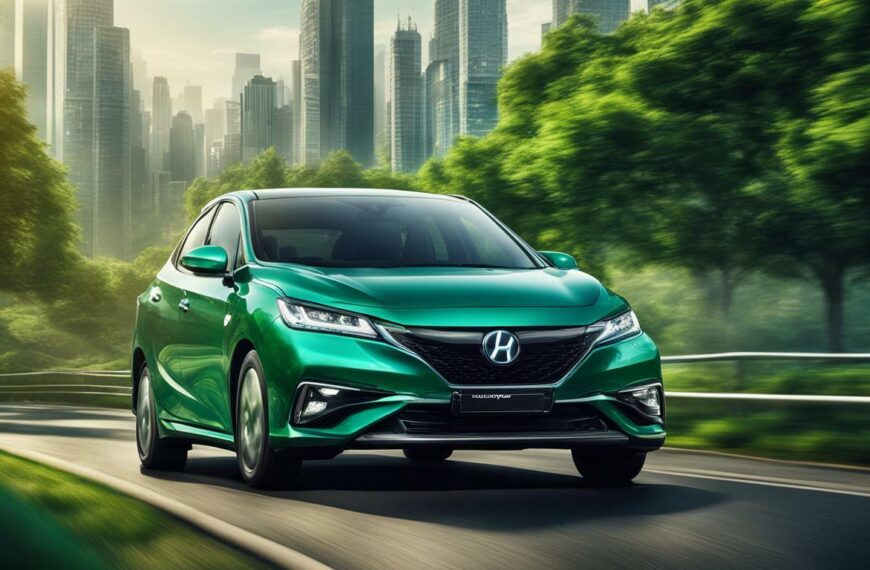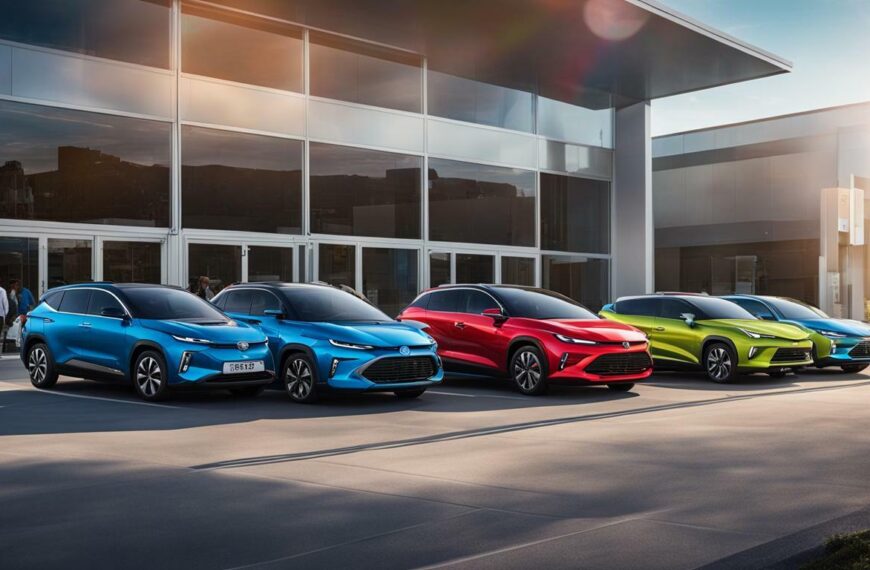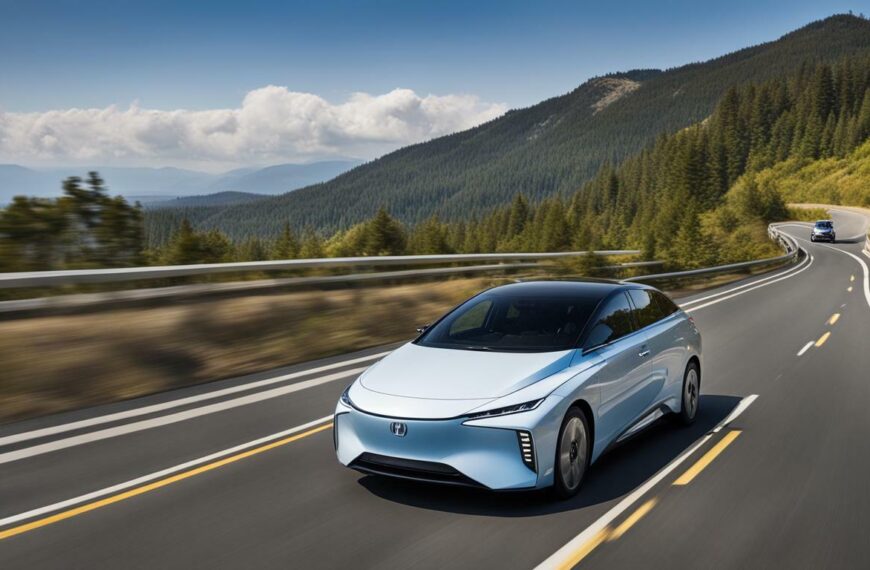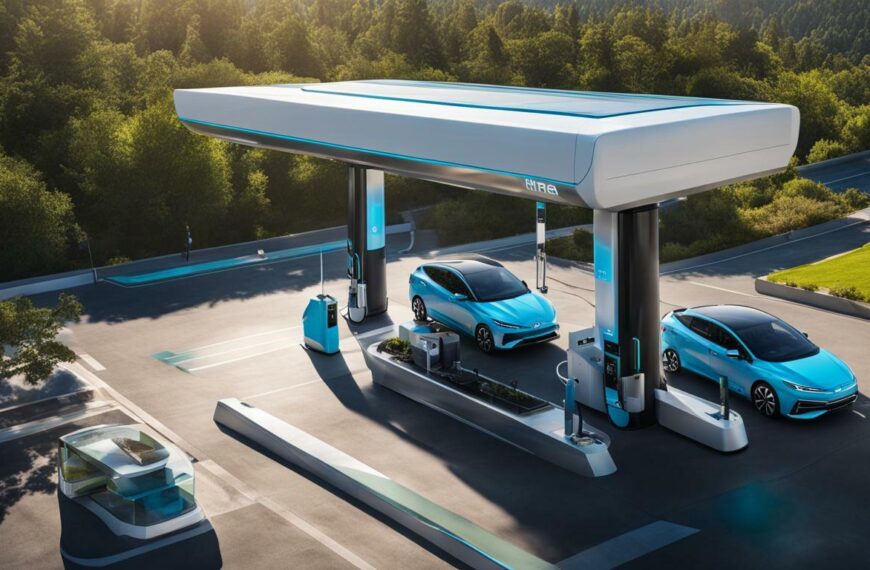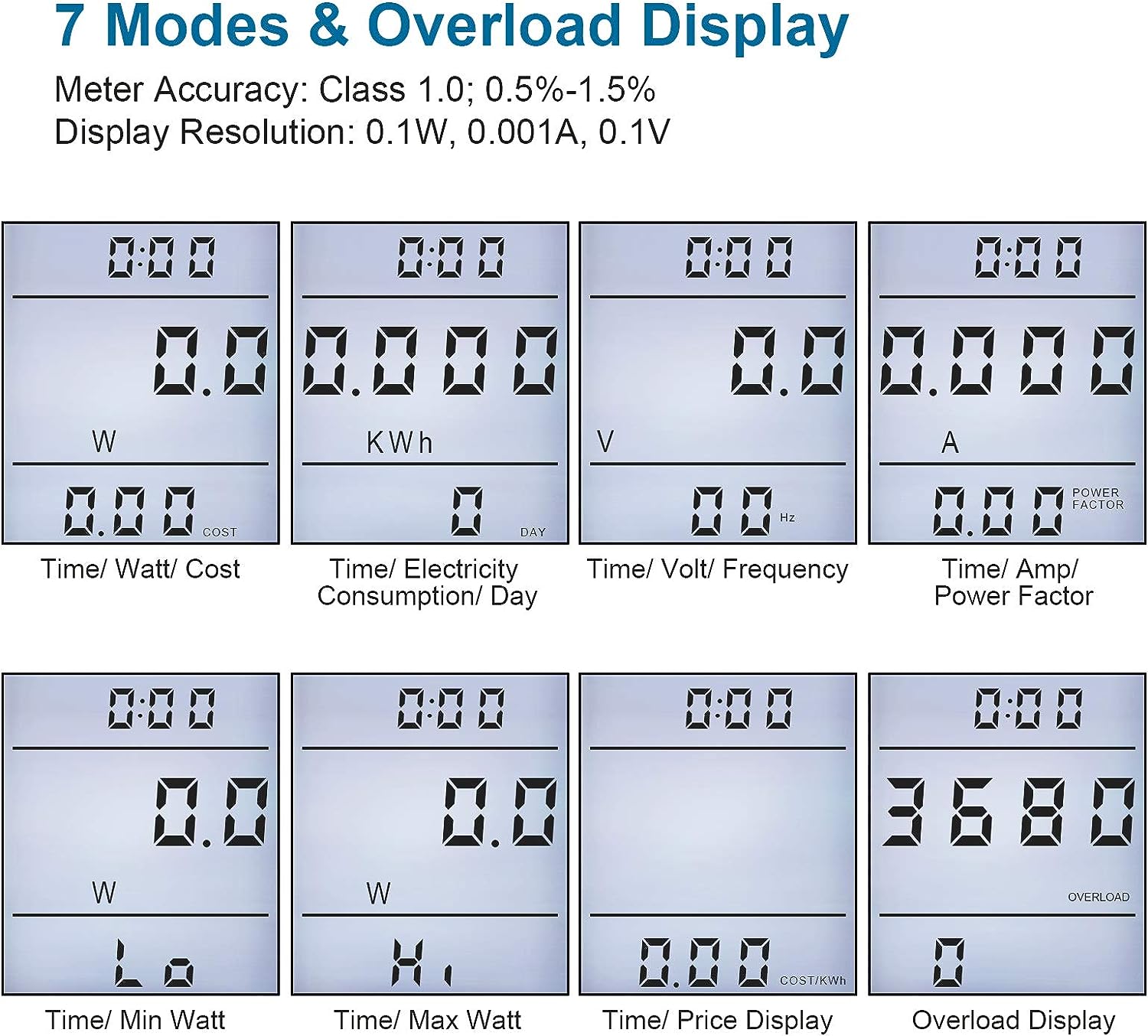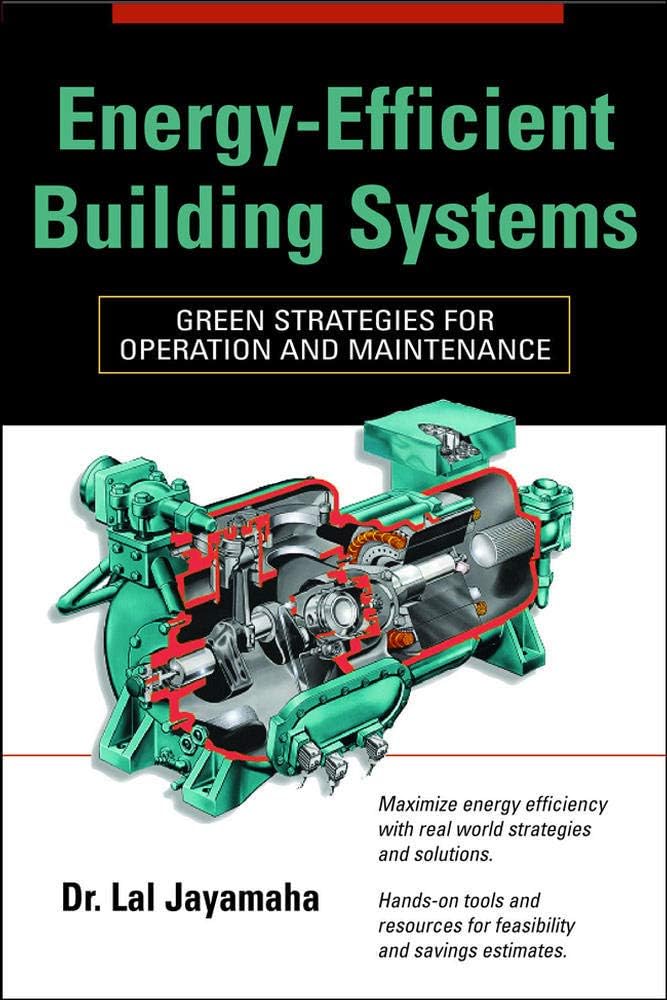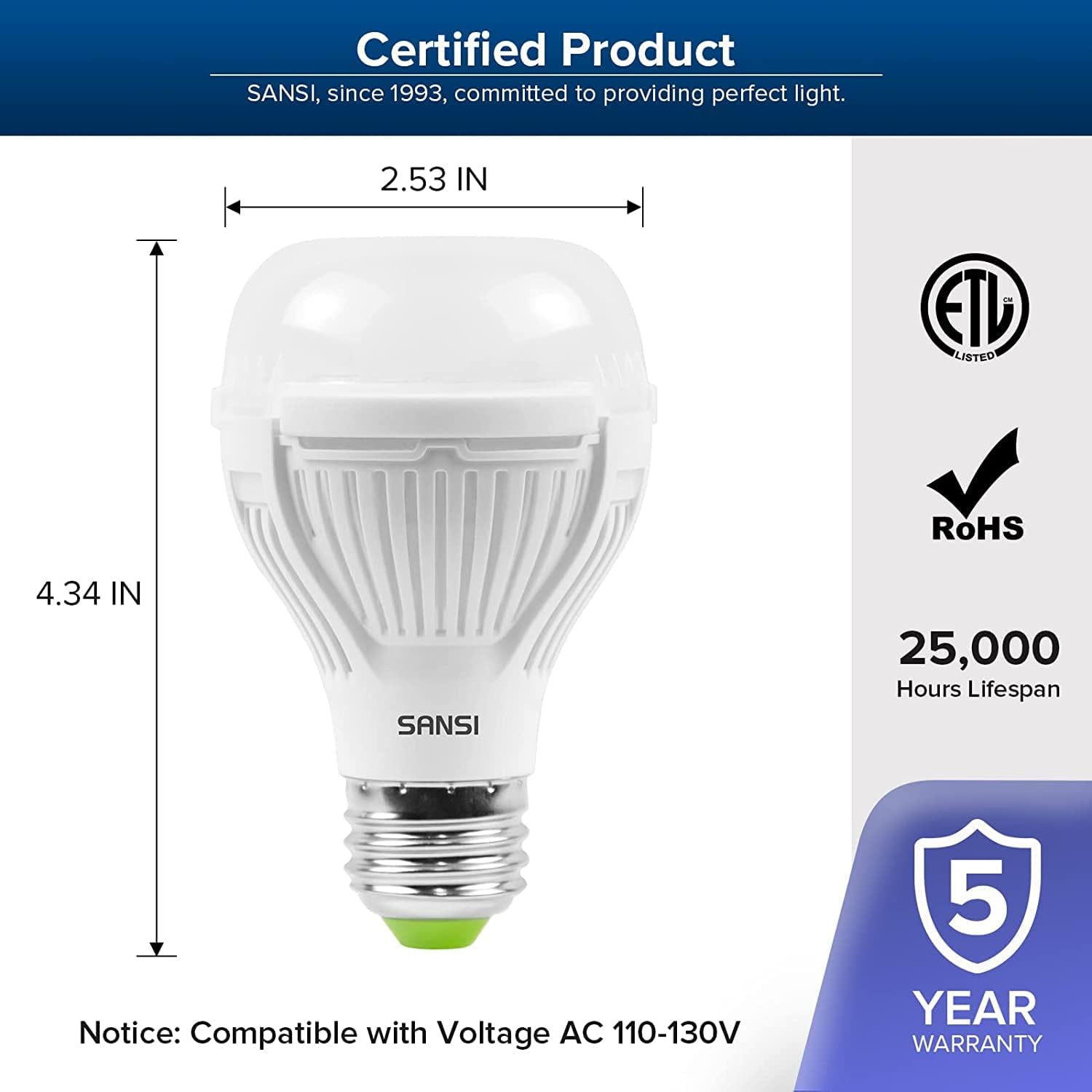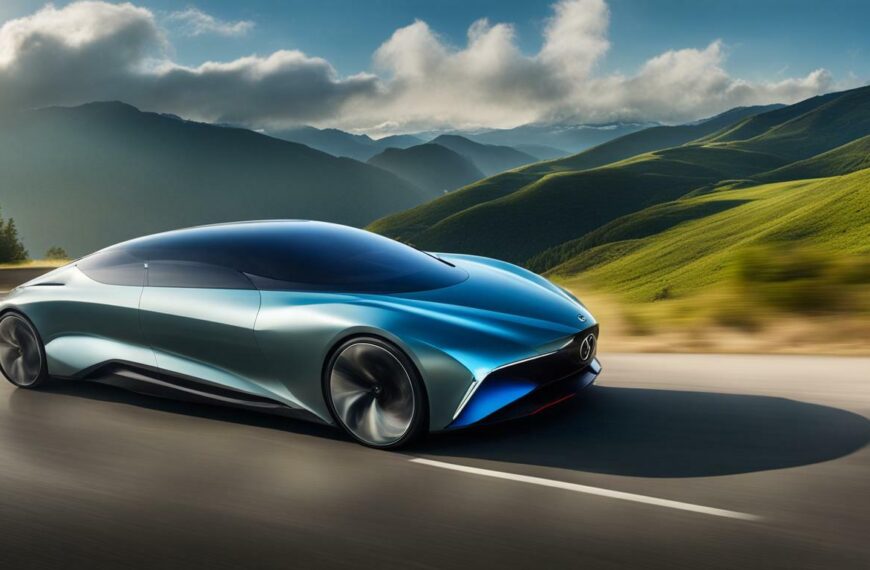Hydrogen fuel cell vehicles, also known as FCEVs, are at the forefront of the next generation of eco-friendly driving. These vehicles utilize electricity to power an electric motor through a fuel cell, which is powered by hydrogen. Unlike traditional electric vehicles that draw electricity from a battery, FCEVs produce their own electricity through the fuel cell.
The power of an FCEV is determined by the size of the electric motor and the combination of the fuel cell and battery. The battery is utilized in various ways, such as recapturing braking energy, providing additional power during acceleration, and idling or turning off the fuel cell during low power needs. The amount of energy stored onboard is determined by the size of the hydrogen fuel tank.
A typical FCEV consists of several components, including a battery pack, DC/DC converter, electric traction motor, fuel cell stack, fuel filler, hydrogen fuel tank, power electronics controller, thermal system for cooling, and transmission. These components work together to provide the necessary power and efficiency for the vehicle.
Currently, there are approximately 15,000 hydrogen-powered vehicles on U.S. roads, with all of them being in California. Hydrogen fuel cell vehicles offer numerous advantages, such as zero greenhouse gas emissions, impressive driving ranges, and quick refueling times. However, they also face challenges, including the lack of infrastructure, the energy-intensive production of hydrogen, and higher vehicle costs compared to traditional gasoline-powered cars and some electric vehicles.
Leading automakers, such as Toyota, Honda, and Hyundai, are driving advancements in hydrogen fuel cell technology. These companies are investing in research and development to improve the efficiency and performance of FCEVs. Governments are also implementing policies and incentives to encourage the adoption of hydrogen fuel cell vehicles. However, widespread adoption relies on significant investments in infrastructure development and green hydrogen production.
Despite the challenges, hydrogen fuel cell vehicles have the potential to play a crucial role in the future of transportation. They offer an environmentally friendly alternative to traditional internal combustion engine vehicles and even certain applications of battery electric vehicles.
- Hydrogen fuel cell vehicles use electricity to power an electric motor through a fuel cell.
- FCEVs produce their own electricity by converting hydrogen into electricity.
- The power and efficiency of FCEVs are determined by the size of the electric motor, fuel cell, and battery combination.
- FCEVs have a battery pack, electric traction motor, fuel cell stack, and various other components.
- Hydrogen fuel cell vehicles offer zero greenhouse gas emissions, impressive driving ranges, and quick refueling times.
Understanding Fuel Cell Vehicles and Their Components
Fuel cell vehicles utilize a hydrogen fuel cell engine, which consists of several key components that work in harmony to generate electricity. These components include a fuel cell stack, a battery pack, a DC/DC converter, an electric traction motor, a fuel filler, a hydrogen fuel tank, a power electronics controller, a thermal system for cooling, and a transmission. Let’s dive deeper into each of these components and understand their role in powering a fuel cell vehicle.
At the heart of a fuel cell vehicle is the fuel cell stack. This stack contains multiple individual fuel cells that generate electricity through an electrochemical reaction between hydrogen and oxygen. This reaction produces water vapor as a byproduct, making fuel cell vehicles emission-free. The electricity generated by the fuel cell stack is then supplied to an electric traction motor, which is responsible for converting it into mechanical energy to drive the vehicle.
In addition to the fuel cell stack, fuel cell vehicles are equipped with a battery pack. The battery pack serves multiple purposes in the vehicle’s powertrain. It can store excess energy generated by the fuel cell stack during regenerative braking and provide additional power during acceleration when the demand for energy exceeds the capacity of the fuel cell. The battery pack also allows the fuel cell to idle or turn off during low power requirements, improving overall efficiency.
The other components, such as the DC/DC converter, power electronics controller, thermal system for cooling, and transmission, work together to ensure the smooth operation of the fuel cell vehicle. The DC/DC converter converts the high-voltage electricity generated by the fuel cell stack into the appropriate voltage to power various systems in the vehicle. The power electronics controller manages the flow of electricity between the fuel cell stack, battery pack, and electric traction motor, optimizing energy usage. The thermal system for cooling helps regulate the temperature of the fuel cell stack and other components to maintain optimal performance. Finally, the transmission transfers the mechanical power from the electric traction motor to the wheels, propelling the vehicle forward.
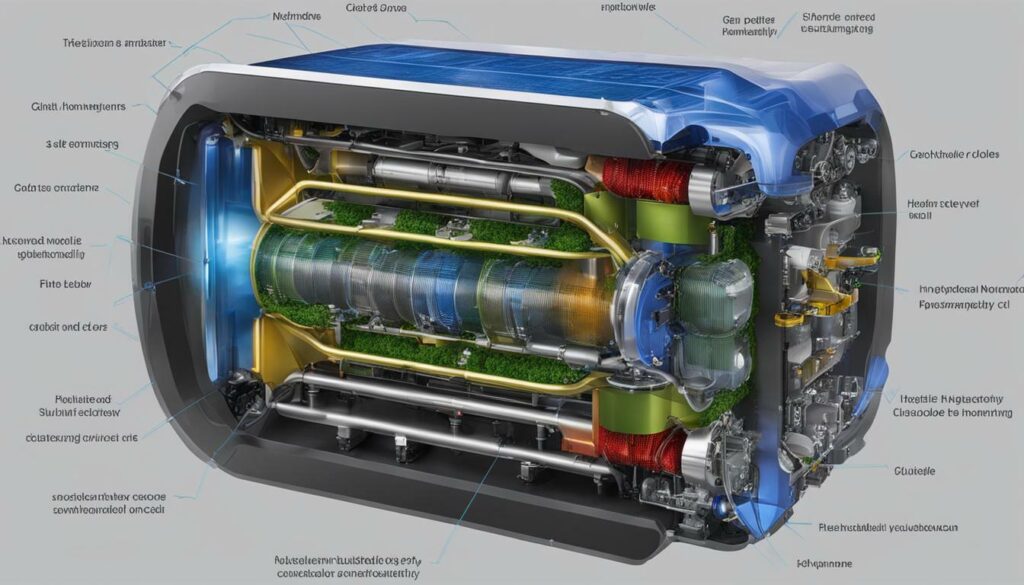
| Component | Description |
|---|---|
| Fuel Cell Stack | Generates electricity through the electrochemical reaction of hydrogen and oxygen. |
| Battery Pack | Stores excess energy and provides additional power during acceleration. |
| DC/DC Converter | Converts high-voltage electricity from the fuel cell stack for use in various systems. |
| Electric Traction Motor | Converts electricity into mechanical energy to drive the vehicle. |
| Fuel Filler | Allows for the refueling of hydrogen into the vehicle’s hydrogen fuel tank. |
| Hydrogen Fuel Tank | Stores hydrogen to be used in the fuel cell stack. |
| Power Electronics Controller | Manages the flow of electricity between the fuel cell stack, battery pack, and electric traction motor. |
| Thermal System for Cooling | Regulates the temperature of the fuel cell stack and other components for optimal performance. |
| Transmission | Transfers the mechanical power from the electric traction motor to the wheels. |
The Power of Hydrogen Fuel Cell Reaction
The heart of a hydrogen fuel cell vehicle lies in its ability to convert hydrogen and oxygen into electricity through a controlled chemical reaction. This process takes place within the fuel cell stack, which consists of multiple fuel cells connected in series. Each fuel cell contains an anode, a cathode, and an electrolyte membrane that separates them.
The anode receives hydrogen gas, which then undergoes a catalytic reaction that splits the hydrogen molecules into protons and electrons. The protons pass through the electrolyte membrane, while the electrons take an external path, creating an electric current that can be harnessed to power the vehicle’s electric motor and other electronic systems.
Meanwhile, at the cathode, oxygen from the air combines with the protons and electrons from the anode to produce water as a byproduct. This chemical reaction occurs without combustion, resulting in zero greenhouse gas emissions and only water vapor being released from the vehicle’s tailpipe.
| Advantages of Hydrogen Fuel Cell Reaction |
|---|
| Zero greenhouse gas emissions |
| High energy conversion efficiency |
| Quiet operation |
| Consistent power output |
The efficiency of the hydrogen fuel cell reaction plays a crucial role in the performance of a fuel cell vehicle. It determines how effectively hydrogen is converted into electricity, thus impacting factors such as the driving range and overall energy consumption. Ongoing research and development efforts focus on improving the efficiency of fuel cell systems, including the design of more efficient catalysts and advancements in membrane technology.
Overall, the power generated by the hydrogen fuel cell reaction enables hydrogen fuel cell vehicles to provide a clean and sustainable transportation solution. By harnessing the power of hydrogen and oxygen, these vehicles offer a viable alternative to traditional gasoline-powered cars and certain electric vehicles, contributing to a greener and more sustainable future of transportation.

Hydrogen-powered vehicles employ a battery pack and an electric traction motor, working in tandem with the fuel cell system, to ensure optimal performance. The battery pack is responsible for storing and supplying power to the electric motor, providing additional boost during acceleration and recapturing energy during braking. This collaboration between the battery and electric motor enhances the overall efficiency of hydrogen fuel cell vehicles.
The electric traction motor, powered by the battery pack, drives the vehicle’s wheels, delivering the necessary mechanical power for propulsion. As the motor operates, it draws electricity from the fuel cell system, which produces electricity through a chemical reaction between hydrogen and oxygen. This symbiotic relationship between the battery, electric motor, and fuel cell system allows for dynamic power management and enables FCEVs to adapt to various driving conditions.
With their ability to efficiently convert and store energy, battery packs play a vital role in the overall energy management of hydrogen fuel cell vehicles. They provide instantaneous power when needed, ensuring smooth acceleration and improved overall performance. Additionally, the battery pack allows for the recapture of excess energy during regenerative braking, maximizing energy efficiency and extending the vehicle’s range.
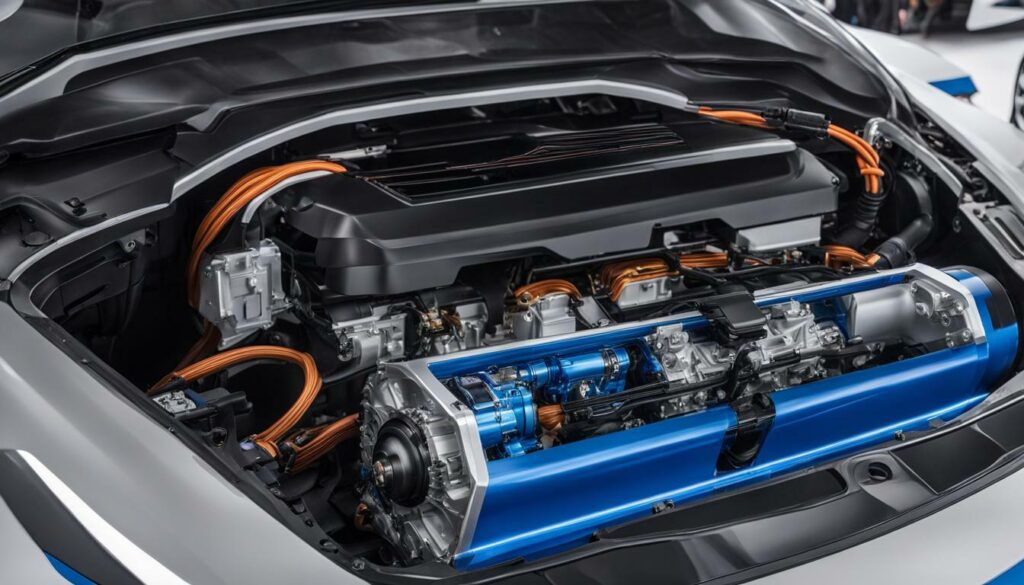
The diagram above illustrates the integration of the battery pack, electric traction motor, and fuel cell stack in the powertrain of a hydrogen fuel cell vehicle. It showcases the collaborative nature of these components and their role in providing efficient and sustainable transportation. This innovative technology highlights the potential of FCEVs as a viable alternative to traditional internal combustion engine vehicles and battery electric vehicles.
The Benefits of Battery and Electric Motor Integration
- Enhanced energy efficiency: The integration of the battery pack and electric motor allows for intelligent energy management, optimizing power distribution and minimizing energy waste.
- Improved performance: The collaboration between the battery and electric motor provides instant power delivery, resulting in responsive acceleration and a smooth driving experience.
- Regenerative braking: The battery pack can recapture energy during braking, converting it into usable electricity and extending the overall range of the vehicle.
- Reduced reliance on fuel cell: By utilizing the battery pack for low power demands, FCEVs can idle or turn off the fuel cell, preserving hydrogen and improving fuel efficiency.
Conclusion
The integration of the battery pack and electric motor in hydrogen fuel cell vehicles plays a crucial role in their performance, efficiency, and overall viability. This collaboration enables FCEVs to deliver power on demand, maximize energy efficiency through regenerative braking, and reduce reliance on the fuel cell. With advancing technology and the commitment of automakers like Toyota, Honda, and Hyundai, hydrogen fuel cell vehicles are steadily becoming a promising solution for sustainable transportation.
However, challenges such as infrastructure development, hydrogen production efficiency, and vehicle costs need to be addressed for widespread adoption. As investments in green hydrogen production and infrastructure increase, hydrogen fuel cell vehicles have the potential to become a key player in the future of transportation, offering an environmentally friendly alternative for a variety of applications.
Energy Storage and Efficiency in FCEVs
The energy stored onboard a hydrogen fuel cell vehicle is determined by the size of the hydrogen fuel tank, ensuring extended driving ranges and improved efficiency. Hydrogen fuel cell vehicles offer a promising solution for long-range transportation, as they can store a larger quantity of energy compared to conventional batteries used in electric vehicles. This enables FCEVs to travel farther distances without the need for frequent refueling.
One of the key advantages of hydrogen fuel cell vehicles is their impressive driving ranges. FCEVs can travel up to 300 miles or more on a single tank of hydrogen, offering similar ranges to traditional gasoline-powered cars. This long driving range makes hydrogen fuel cell vehicles a viable option for those who need to cover substantial distances without worrying about recharging or refueling.
Moreover, the energy stored onboard hydrogen fuel cell vehicles can be efficiently converted into electricity, allowing for high energy conversion rates and improved efficiency. In a fuel cell stack, hydrogen reacts with oxygen from the air to produce electricity, emitting only water vapor as a byproduct. This clean and efficient process contributes to reducing greenhouse gas emissions, addressing environmental concerns associated with conventional internal combustion engines.

While hydrogen fuel cell vehicles offer significant advantages in terms of energy storage and efficiency, they currently face some challenges. The lack of a comprehensive hydrogen infrastructure, including refueling stations, limits the widespread adoption of FCEVs. Additionally, the production of hydrogen using renewable energy sources is energy-intensive, which can impact the overall efficiency of FCEVs.
| Advantages of Hydrogen Fuel Cell Vehicles | Challenges Faced by FCEVs |
|---|---|
|
|
Despite these challenges, leading automakers such as Toyota, Honda, and Hyundai are actively investing in hydrogen fuel cell technology and development. Governments around the world are also implementing policies and incentives to encourage the adoption of hydrogen fuel cell vehicles. However, significant investment in infrastructure and green hydrogen production is still needed to facilitate widespread adoption and maximize the potential of these vehicles.
Exploring the Components of a Hydrogen Fuel Cell Vehicle
A hydrogen fuel cell vehicle consists of various components, such as a fuel filler, hydrogen fuel tank, power electronics controller, thermal system for cooling, transmission, and DC/DC converter. Each of these components plays a crucial role in the operation and efficiency of the vehicle.
The fuel filler is where hydrogen, the primary fuel source, is filled into the vehicle. The hydrogen fuel tank stores the hydrogen, which is then used by the fuel cell stack to generate electricity. The power electronics controller manages the flow of electricity between the fuel cell, battery, and electric traction motor, ensuring optimal performance and efficiency. The thermal system for cooling helps maintain the temperature of the fuel cell and other components, ensuring their longevity and efficient operation.
The transmission is responsible for transferring the power from the electric motor to the wheels, allowing the vehicle to move. The DC/DC converter helps regulate the voltage between the fuel cell stack and the battery pack, ensuring compatibility and efficient power distribution. These components work together harmoniously to provide a smooth and reliable driving experience.
| Component | Function |
|---|---|
| Fuel Filler | Where hydrogen is filled into the vehicle |
| Hydrogen Fuel Tank | Stores hydrogen for fuel cell operation |
| Power Electronics Controller | Manages electricity flow between fuel cell, battery, and motor |
| Thermal System for Cooling | Maintains optimal temperature of fuel cell and components |
| Transmission | Transfers power from electric motor to wheels |
| DC/DC Converter | Regulates voltage between fuel cell stack and battery pack |
Understanding the components of a hydrogen fuel cell vehicle allows us to appreciate the complexity and ingenuity behind this innovative technology. As automakers like Toyota, Honda, and Hyundai continue to advance hydrogen fuel cell technology, we can anticipate further enhancements in performance, efficiency, and reliability. However, the widespread adoption of hydrogen fuel cell vehicles relies on significant investments in infrastructure development and green hydrogen production. With continued support and incentives from governments around the world, hydrogen fuel cell vehicles have the potential to revolutionize the future of transportation, offering an environmentally friendly and sustainable alternative to traditional internal combustion engine vehicles.
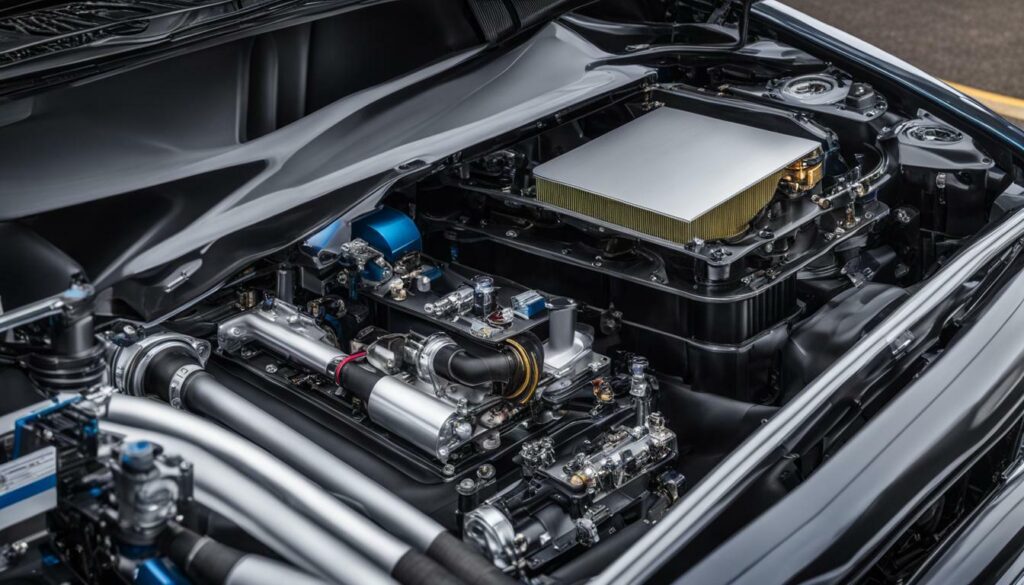
- Fuel Filler
- Hydrogen Fuel Tank
- Power Electronics Controller
- Thermal System for Cooling
- Transmission
- DC/DC Converter
“Hydrogen fuel cell vehicles are at the forefront of sustainable transportation, utilizing advanced components such as fuel fillers, hydrogen fuel tanks, power electronics controllers, thermal systems for cooling, transmissions, and DC/DC converters. These technologies work in harmony to propel us towards a greener and more efficient future.”
In conclusion, hydrogen fuel cell vehicles offer a promising solution to reduce greenhouse gas emissions and address the challenges of limited driving ranges and long refueling times faced by some battery electric vehicles. The components within these vehicles, such as the fuel filler, hydrogen fuel tank, power electronics controller, thermal system for cooling, transmission, and DC/DC converter, work together to provide a seamless driving experience while minimizing environmental impact. As more automakers invest in hydrogen fuel cell technology and governments support its adoption, we can expect significant advancements in infrastructure and production methods. With continued progress, hydrogen fuel cell vehicles have the potential to transform the future of transportation, offering a sustainable alternative for a cleaner and greener world.
The Current State of Hydrogen Fuel Cell Vehicles
Presently, there are approximately 15,000 hydrogen-powered vehicles on U.S. roads, with the majority concentrated in California. These hydrogen fuel cell vehicles, or FCEVs, represent a growing segment in the automotive industry, offering a promising solution to combat climate change and reduce dependence on fossil fuels.
With their zero greenhouse gas emissions, FCEVs are seen as an environmentally friendly option for drivers seeking an alternative to traditional internal combustion engine vehicles. Not only do these vehicles produce no harmful emissions, but they also offer impressive driving ranges, often surpassing their battery electric counterparts. Plus, refueling a hydrogen fuel cell vehicle is as quick and convenient as refueling a gasoline-powered car, with fill-up times comparable to traditional refueling.
However, despite these benefits, the adoption of hydrogen fuel cell vehicles still faces challenges. The lack of infrastructure, including hydrogen refueling stations, remains a significant barrier to widespread adoption. Additionally, the energy-intensive production of hydrogen poses its own challenges in terms of sustainability and cost-effectiveness. Furthermore, the higher vehicle costs associated with hydrogen fuel cell technology compared to traditional gasoline-powered cars and even some electric vehicles can limit their accessibility to consumers.
| Advantages of Hydrogen Fuel Cell Vehicles | Challenges Faced by Hydrogen Fuel Cell Vehicles |
|---|---|
|
|
Despite these challenges, several leading automakers, including Toyota, Honda, and Hyundai, are investing in hydrogen fuel cell technology and driving advancements in this field. Governments are also playing a crucial role in promoting the adoption of FCEVs by implementing policies and incentives. However, significant investment in infrastructure development and green hydrogen production is still required for these vehicles to achieve widespread adoption.
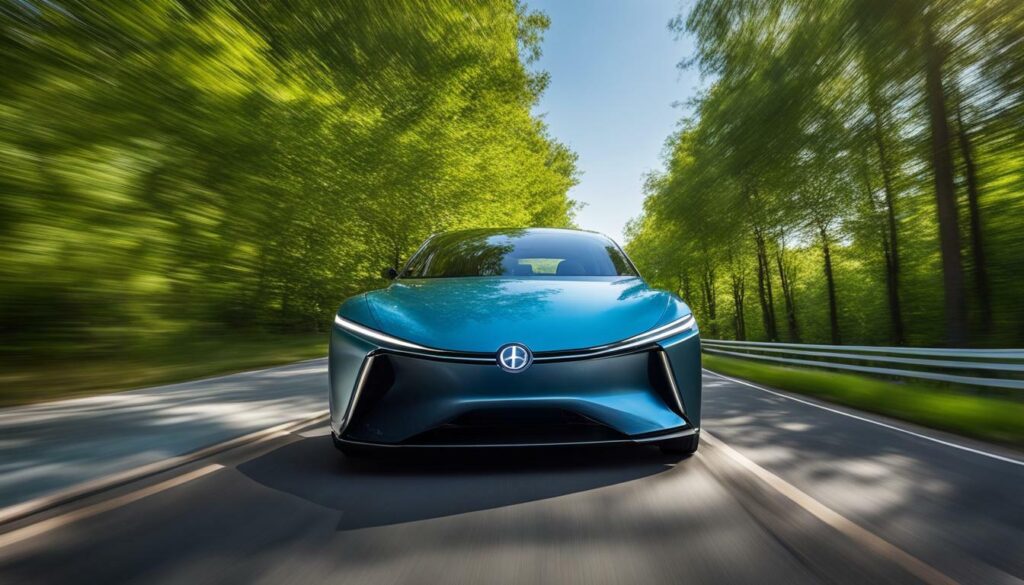
Hydrogen fuel cell vehicles have the potential to revolutionize the future of transportation, offering a low-emission and efficient alternative to traditional gasoline-powered cars and certain electric vehicles. As technology continues to evolve and infrastructure catches up with demand, these vehicles may become increasingly prevalent on roads worldwide, contributing to a greener and more sustainable future.
Advantages and Benefits of Hydrogen Fuel Cell Vehicles
Hydrogen fuel cell vehicles possess numerous advantages, including zero greenhouse gas emissions, impressive driving ranges, and rapid refueling times. Unlike traditional gasoline-powered cars, FCEVs produce only water vapor as a byproduct, making them a clean and sustainable alternative. This zero-emission feature addresses the pressing need for reducing carbon footprints and combating climate change.
Moreover, hydrogen fuel cell vehicles offer impressive driving ranges, eliminating the range anxiety commonly associated with electric vehicles. With advancements in fuel cell technology, FCEVs can travel hundreds of miles before refueling, making them a viable option for long-distance travel and everyday commuting.
When it comes to refueling, hydrogen fuel cell vehicles provide a significant advantage over electric vehicles. Rather than waiting for hours to recharge a battery, FCEVs can be refueled in a matter of minutes, similar to traditional gasoline-powered cars. This quick refueling time offers convenience and eliminates the need for extended charging infrastructure, making FCEVs more practical for drivers.
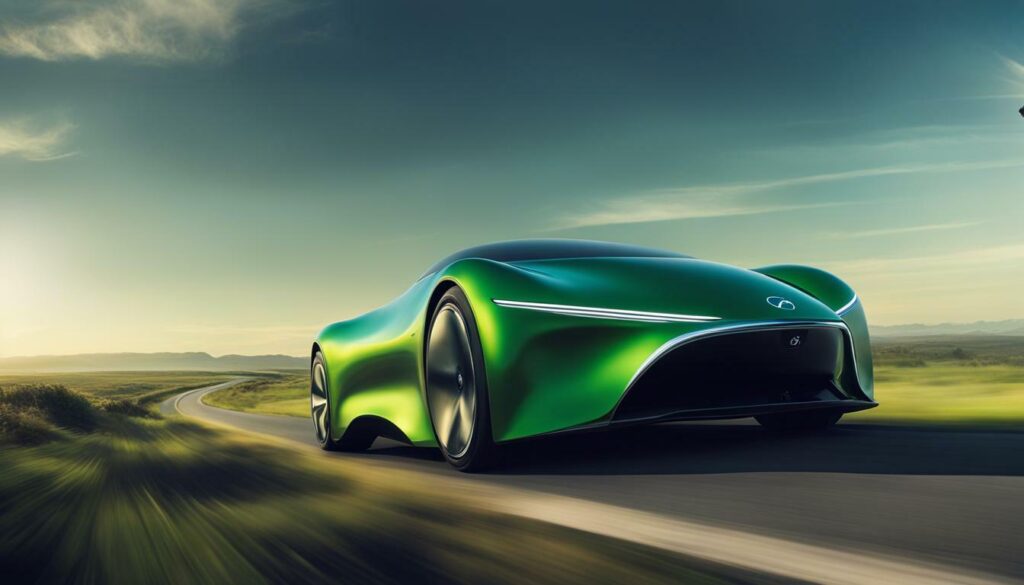
| Advantages of Hydrogen Fuel Cell Vehicles | Benefits |
|---|---|
| Zero greenhouse gas emissions | Reduces carbon footprint and supports cleaner air |
| Impressive driving ranges | Eliminates range anxiety and provides long-distance travel capabilities |
| Rapid refueling times | Offers convenience and eliminates the need for extended charging infrastructure |
In summary, hydrogen fuel cell vehicles offer a range of advantages and benefits that position them as a promising solution for the future of transportation. With zero greenhouse gas emissions, impressive driving ranges, and rapid refueling times, FCEVs provide a clean, versatile, and convenient alternative to traditional internal combustion engine vehicles and certain electric cars. As automakers continue to invest in hydrogen fuel cell technology and governments implement supportive policies, the widespread adoption of FCEVs holds the potential to revolutionize the way we drive and contribute to a greener and more sustainable future.
Challenges Faced by Hydrogen Fuel Cell Vehicles
Despite their advantages, hydrogen fuel cell vehicles encounter obstacles such as the lack of infrastructure, the energy-intensive nature of hydrogen production, and higher vehicle costs. These challenges pose significant barriers to the widespread adoption of fuel cell technology in the transportation sector. However, efforts are underway to address these issues and pave the way for a future where hydrogen fuel cell vehicles play a more prominent role in our daily lives.
One of the major challenges faced by hydrogen fuel cell vehicles is the lack of infrastructure. Currently, there are limited hydrogen refueling stations available, especially outside of major urban areas. This lack of infrastructure makes it difficult for drivers to refuel their vehicles conveniently, limiting the practicality and viability of hydrogen-powered transportation. Increasing the number of refueling stations and establishing a robust hydrogen distribution network is crucial to overcoming this hurdle.
Another challenge is the energy-intensive production of hydrogen. The process of extracting hydrogen from its sources, such as natural gas or water, requires significant amounts of energy. This energy consumption contributes to the carbon footprint of hydrogen fuel cell vehicles and raises concerns about the overall sustainability of hydrogen as a fuel source. However, advancements in green hydrogen production, such as electrolysis powered by renewable energy sources, are being explored to mitigate this issue and enhance the environmental credentials of hydrogen fuel cell vehicles.
Moreover, higher vehicle costs present a challenge to the wider adoption of hydrogen fuel cell vehicles. The production and integration of fuel cells, hydrogen tanks, and other related components significantly increase the manufacturing costs of FCEVs compared to traditional internal combustion engine vehicles and some battery electric vehicles. As a result, the higher price tag can deter potential buyers and limit the accessibility of hydrogen fuel cell technology. However, ongoing research and development efforts aim to drive down the costs of fuel cell technology and make FCEVs more affordable for consumers.
| Challenges Faced by Hydrogen Fuel Cell Vehicles |
|---|
| Lack of Infrastructure |
| Energy-intensive production of hydrogen |
| Higher vehicle costs |
Overcoming these challenges requires collaborative efforts from various stakeholders, including governments, industry leaders, and research institutions. Governments can play a crucial role by implementing policies and incentives to support the growth of hydrogen fuel cell technology and encouraging investment in infrastructure development. Industry leaders, such as automakers and energy companies, need to continue their commitment to research and development, driving innovation and bringing down the costs associated with FCEVs. Additionally, research institutions can contribute by advancing technologies and finding sustainable solutions for hydrogen production, storage, and distribution.
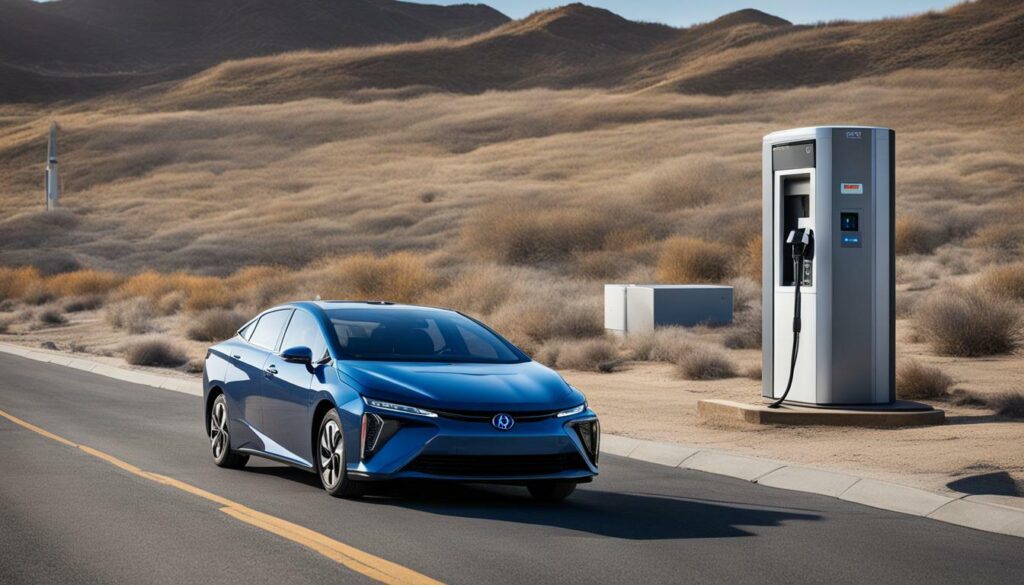
Leading Automakers and Advancements in Hydrogen Fuel Cell Technology
Automotive manufacturers like Toyota, Honda, and Hyundai are at the forefront of hydrogen fuel cell technology, driving innovation and development in the industry. These companies have made significant advancements in the design and production of hydrogen fuel cell vehicles, showcasing their commitment to sustainable transportation.
Toyota, a pioneer in the field, introduced the Toyota Mirai, a hydrogen fuel cell vehicle that has gained recognition for its impressive efficiency and range. The Mirai features Toyota’s advanced fuel cell stack technology, which enables it to convert hydrogen into electricity with minimal waste. With a fully charged hydrogen tank, the Mirai can travel up to 312 miles on a single fill, making it a viable option for long-distance driving.
Honda, on the other hand, has developed the Honda Clarity Fuel Cell, a hydrogen-powered sedan that combines modern design with cutting-edge technology. The Clarity Fuel Cell boasts a spacious interior, providing a comfortable and refined driving experience. Equipped with a powerful fuel cell stack, the Clarity Fuel Cell offers enhanced performance and efficiency, solidifying Honda’s position as a key player in the hydrogen fuel cell vehicle market.
Hyundai has also made significant strides in hydrogen fuel cell technology with the Hyundai Nexo. The Nexo showcases Hyundai’s innovation and commitment to sustainable mobility. With a highly efficient fuel cell system, the Nexo delivers outstanding performance and zero greenhouse gas emissions. It also incorporates advanced safety features and a spacious interior, offering an all-around exceptional driving experience.
As these automakers continue to refine and expand their hydrogen fuel cell vehicle offerings, the future of transportation looks promising. Governments and industry leaders are recognizing the potential of hydrogen fuel cell technology and are implementing policies and incentives to support its adoption. However, further investment in infrastructure development and green hydrogen production is necessary to ensure widespread availability and accessibility of hydrogen fuel for these vehicles to reach their full potential.
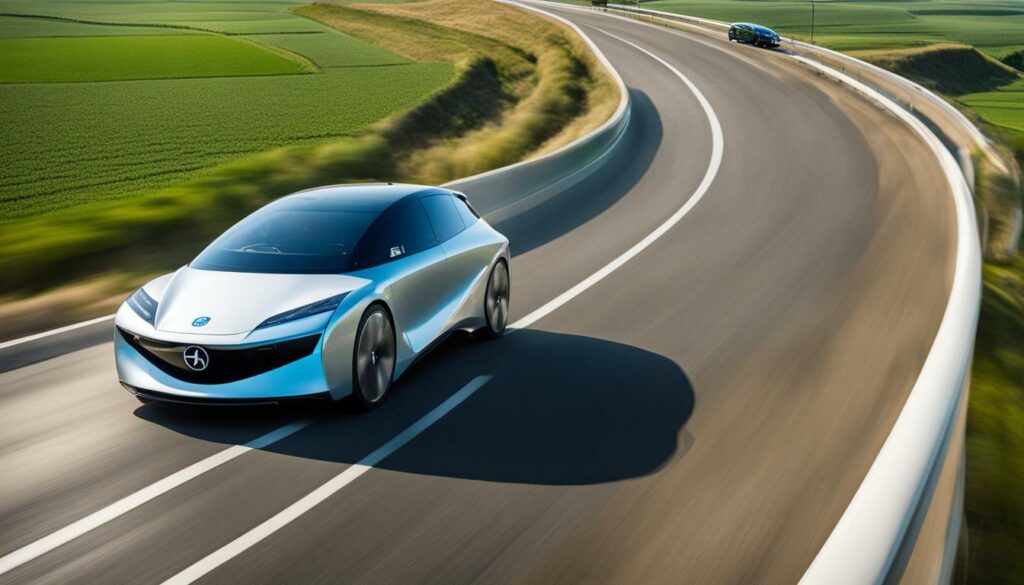
| Automaker | Model | Range |
|---|---|---|
| Toyota | Mirai | 312 miles |
| Honda | Clarity Fuel Cell | 360 miles |
| Hyundai | Nexo | 380 miles |
Conclusion
Hydrogen fuel cell vehicles have the potential to revolutionize transportation, offering an environmentally friendly alternative to traditional internal combustion engine vehicles and even certain applications of battery electric vehicles. These vehicles, also known as FCEVs, use electricity to power an electric motor through a fuel cell powered by hydrogen.
Unlike electric vehicles that rely on a battery, FCEVs produce electricity through the fuel cell, with the power of the vehicle determined by the size of the electric motor and the fuel cell and battery combination. The battery in FCEVs plays a crucial role in recapturing braking energy, providing additional power during acceleration, and idling or turning off the fuel cell during low power needs.
The energy storage onboard FCEVs is determined by the size of the hydrogen fuel tank, with several components working together to ensure the vehicle’s optimal performance. These components include the battery pack, DC/DC converter, electric traction motor, fuel cell stack, fuel filler, hydrogen fuel tank, power electronics controller, thermal system for cooling, and transmission.
Currently, there are around 15,000 hydrogen-powered vehicles on U.S. roads, all of which are located in California. Despite their numerous advantages, such as zero greenhouse gas emissions, impressive driving ranges, and quick refueling times, hydrogen fuel cell vehicles still face challenges. These challenges include the lack of infrastructure, energy-intensive production of hydrogen, and higher vehicle costs compared to traditional gasoline-powered cars and some electric vehicles.
Leading automakers, including Toyota, Honda, and Hyundai, are making significant contributions to the development of hydrogen fuel cell technology. Governments are also implementing policies and incentives to drive the adoption of these vehicles. However, widespread adoption requires substantial investment in infrastructure and green hydrogen production.
As we look to the future of transportation, hydrogen fuel cell vehicles show great promise as an environmentally friendly alternative. With their potential to reduce emissions and offer efficient, long-range travel, FCEVs have the ability to transform the way we commute and contribute to a more sustainable future.
FAQ
How do hydrogen fuel cell vehicles work?
Hydrogen fuel cell vehicles use electricity to power an electric motor using a fuel cell powered by hydrogen. They produce electricity through the fuel cell instead of drawing it from a battery.
What components are found in a hydrogen fuel cell vehicle?
A hydrogen fuel cell vehicle consists of a battery pack, a DC/DC converter, an electric traction motor, a fuel cell stack, a fuel filler, a hydrogen fuel tank, a power electronics controller, a thermal system for cooling, and a transmission.
How is the power of a hydrogen fuel cell vehicle determined?
The power of a hydrogen fuel cell vehicle is determined by the size of the electric motor and the fuel cell and battery combination.
How is energy stored in a hydrogen fuel cell vehicle?
The energy stored onboard a hydrogen fuel cell vehicle is determined by the size of the hydrogen fuel tank. The vehicle can also use the battery for recapturing braking energy, providing extra power during acceleration, and idling or turning off the fuel cell during low power needs.
How many hydrogen fuel cell vehicles are currently on U.S. roads?
Currently, there are about 15,000 hydrogen-powered vehicles on U.S. roads, all of which are located in California.
What are the advantages of hydrogen fuel cell vehicles?
Hydrogen fuel cell vehicles offer several advantages, including zero greenhouse gas emissions, impressive driving ranges, and quick refueling times.
What challenges do hydrogen fuel cell vehicles face?
Hydrogen fuel cell vehicles face challenges such as the lack of infrastructure, the energy-intensive production of hydrogen, and higher vehicle costs compared to traditional gasoline-powered cars and some electric vehicles.
Which automakers are leading the way in hydrogen fuel cell technology?
Several automakers, including Toyota, Honda, and Hyundai, are leading the way in hydrogen fuel cell technology and development.
Are governments implementing policies to encourage the adoption of hydrogen fuel cell vehicles?
Yes, governments are implementing policies and incentives to encourage the adoption of hydrogen fuel cell vehicles, although significant investment in infrastructure and green hydrogen production is still needed for widespread adoption.
How do hydrogen fuel cell vehicles compare to traditional internal combustion engine vehicles and electric vehicles?
Hydrogen fuel cell vehicles offer an environmentally friendly alternative to traditional internal combustion engine vehicles and even some electric vehicles in certain applications.

